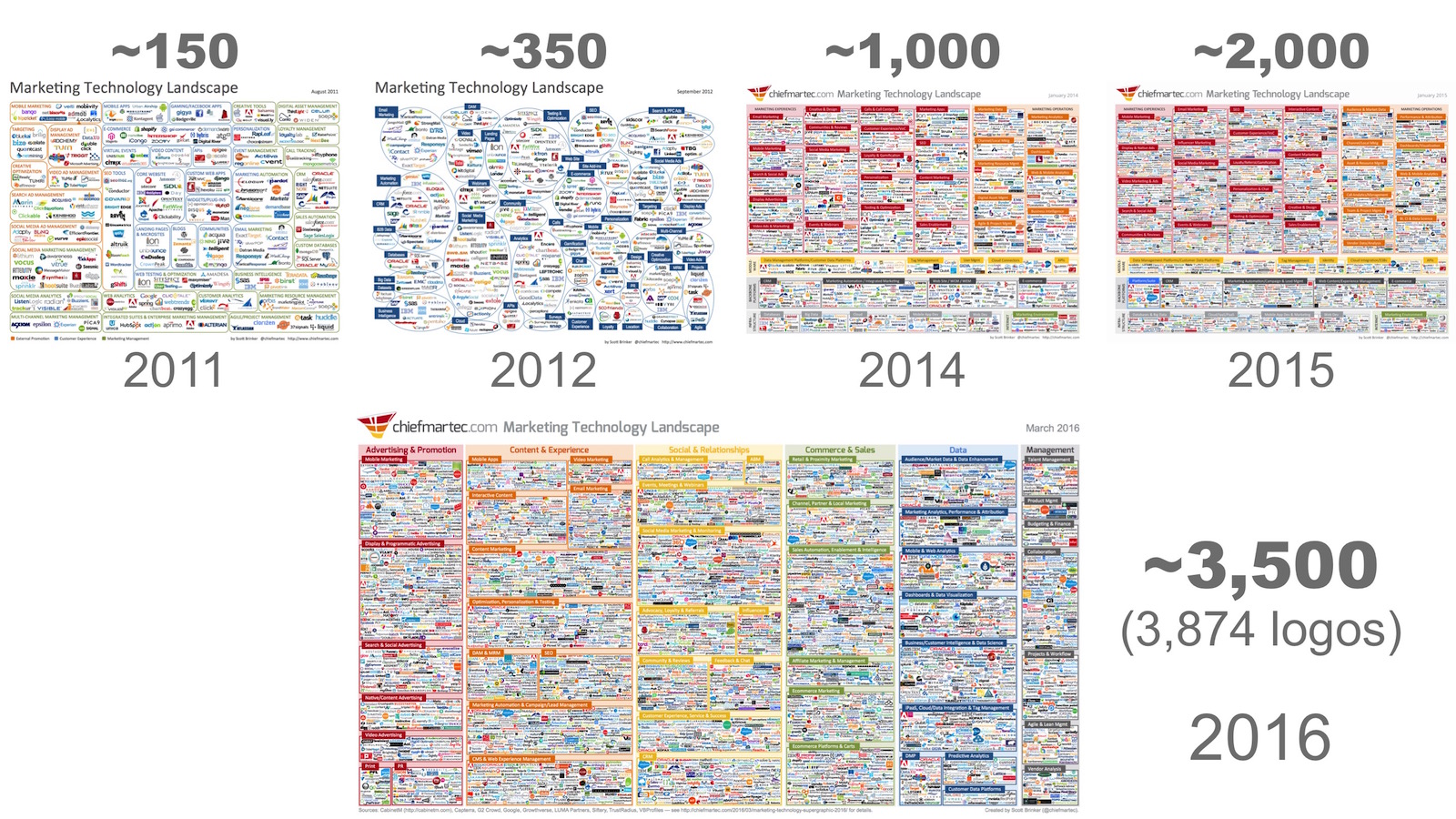 Consumers increasingly demand and expect a fluid, quality digital experience across all channels and devices. Experiences are happening everywhere online, and the onus is on brands to act as publishers to deliver a personalized, omnichannel experience. That’s a pretty tall order, but if you can keep just a few key guidelines in mind you will be able to begin this process with a slight advantage.
Consumers increasingly demand and expect a fluid, quality digital experience across all channels and devices. Experiences are happening everywhere online, and the onus is on brands to act as publishers to deliver a personalized, omnichannel experience. That’s a pretty tall order, but if you can keep just a few key guidelines in mind you will be able to begin this process with a slight advantage.
Digital Marketing Challenges in 2017
Since “omni”-anything can get a bit overwhelming, let’s break out what specific sorts of challenges marketers are facing in 2017 and beyond.
Tool Explosion- Ever-increasing sophistication in ever-more categories makes integration mandatory but difficult.
Personalization- Consumers expect digital experiences to be personal.
Data Science- Big-data collection, analysis, real-time, across disparate SaaS and internal systems.
Diversity- Growing combinations of disparate locations, devices, times, ages, intents, and customer lifecycles compound the challenge of personalization.
Agencies- Global projects and specialization require many teams for execution, and managing everything in-house is becoming increasingly difficult.
Security- Everyone is scared, no one is confident, and your brand is ultimately at stake if things go wrong.
Technology is Meeting the Demand
Fortunately, technology is keeping apace with consumer demands. As noted by Gartner, a leading technology consulting company, “Advances in technology are enabling a new level of possibility, and the aspirations of innovative companies are increasing accordingly.”
As consumer expectations change, the tools and technologies are increasingly available to even small companies looking to meet and exceed those expectations.
These are all best-in-class software as a service (SaaS) options, which is as awesome as it is terrifying for marketers looking to implement these types of technologies: (view larger graphic)
What Winning Online Looks Like
It’s one thing to think you’re delivering great brand experiences that are powering a positive return on investment, but it’s quite another to know it.
So what defines a winning digital experience? If you are just looking at your “bottom line,” you’ll likely miss the forest for the trees. To really gauge how you’re doing, it’s useful to measure your “bottom lines” in six key areas:
1. Growth- Digital Experiences Must Drive Sales or Customer Acquisition
Growth is always the #1 imperative. The Internet is only getting noisier, so attracting new customers while keeping your existing churn rate low should be a company’s primary focus. Any individual or company anywhere in the world has the same megaphone of free and widely accessible tools as you do.
In the “good” old days, outspending competitors was enough, but now viral content can trounce even millions of dollars invested in advertising. This is what makes content marketing so centrally important, since it’s increasingly content—not ads—that tell your brand story. In his article, Ari Kurtz of Google points out that the new era of video advertising is content-as-ads. So these days even our ads are content!
2. Engagement- Customer-Centric Strategy that Delivers Personalized, Omni-Channel Experiences
Engagement is the difference between advertising and a digital experience. Being “engaged” requires knowing who you are talking to, understanding why they are interacting with your brand, and leads to questions like “What problem are you trying to solve?” and “Are you a new or existing customer?”
The challenges of delivering that sort of personalized experience at scale are vast. There are numerous factors at play, including device, language, placement along the customer journey, personal preferences, etc. That said, the rewards for doing so are potentially huge!
This all comes down to leveraging data to deliver the right message at the right place and time. But you don’t have to do everything all at once (and risk doing nothing). Work on some email newsletter segmenting and automation, for example. And if you know someone, say, recently bought a Kindle, why are you marketing a lower end model to them. (ahem, Amazon)
3. Performance- Site Speed and Availability Accelerates Acquisition and Engagement
On the Internet, LACK of speed kills. Conversion rates fall when your site is slow. Period. People will not wait for your slow site to load over the 3G network on their phones. They will move on and your opportunity will be lost. All that work down the drain.
Security is another key component of site performance. Everyone is scared about security breaches and hacks, no one is (or can be) 100% confident, and entire brands are at stake. Do you really want to leave all that risk on the table. Neglect site speed and security at your own peril!
Fortunately, companies like WP Engine are here to help. 🙂 Google also provides tools to help you check your site speed and mobile friendliness.
4. Integration- SaaS tools & Services Mandate Integration, Overlapping, & Sharing Data
Earlier we mentioned that technology is doing a good job keeping up with consumer expectations. Yet no single technology does it all, which means you have to integrate. Again, that’s no easy task, but there are innovative options available to say, layer into your sales funnel.
For example, have you experimented with Facebook’s automated chat box sales service? I recently bought a new phone case after the artificially intelligent bot had a conversation with me and showed me some great options. Sign, sealed, delivered. Powerful stuff, and not many companies are taking advantage of these sorts of opportunities that have very low barriers to entry. Leverage all the new marketing technology companies who are helping make new technology easier, cheaper, and faster to implement.
5. ROI- Investments in Digital Experiences Must Translate to Business Value
Few have the luxury of burning through money for the fun of it. Your digital experiences need to have a positive return on investment. Familiarize yourself with Google Analytics conversion pathways and multi-channels funnel reports. This is one of those areas where marketing and IT folks have a lot in common! Take a close look, where does your funnel leak?
6. Agility- Rapid and constant innovation is critical to maintaining online leadership
It’s one thing to operate with speed, this is something that large companies are usually better at doing because they have more people working on the same problem thus can move faster. But it’s a completely different thing to be agile. Being agile means you can quickly pivot and react, this is where small business can beat out large corporations, as large companies are usually slow to react to change. In today’s globally connected world, markets can change in an instant, and being able to pivot can mean the difference between success and failure. Listen to your audience and react proactively and you’ll have a leg up on bigger rivals!
Find Your Audience, and Deliver
Your mission and challenge as a digital marketer is to go where your audience is and meet them there using digital intelligence.
According to Forrester, “Digital Intelligence is the practice of developing a holistic understanding of customers across digital touchpoints for the purposes of optimizing and perfecting the experiences delivered and decisions made by brands during moments of engagement.”
That’s just a fancy way of saying know your customers and deliver what they’re looking for. They have needs, you have solutions. Meet them in the middle. Use technology to get there, but don’t let it get in the way of building a winning digital experience.

